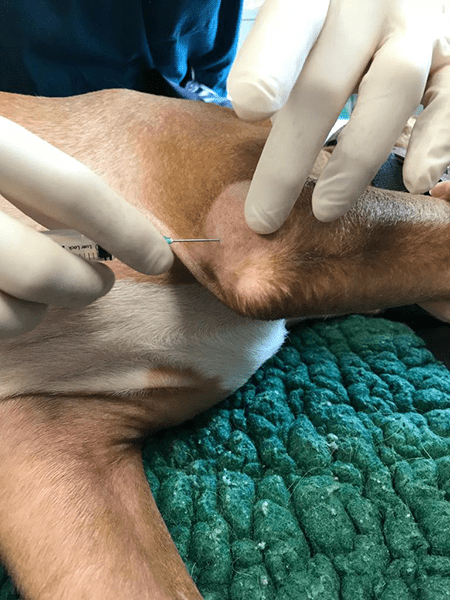
What is Elbow Dysplasia?
Elbow dysplasia (ED) is one of the most common causes of thoracic limb lameness in Labradors and other large and giant breed dogs (1). ED is a term used to describe the presence of one or more developmental conditions involving the elbow joint.
This collective term includes conditions such as medial coronoid disease (MCD), radio-ulnar incongruity, ununited anconeal process (UAP) and osteochondrosis (OCD) (1, 2 ,3 and 4).
These conditions develop in juvenile animals and clinical signs (pain and lameness) are often present at four to six months of age. Many dogs do not present until much later when osteoarthritis (OA) is advanced and lameness is a constant feature.
Techiques for Management
There has been many techniques for both medical and surgical management (arthroscopic treatment, ulnar osteotomies, proximal ulnar osteotomy, distal ulnar osteotomy, Biceps Ulnar release procedure, proximal abducting ulnar osteotomy, sliding humeral osteotomy, canine unicompartment elbow replacement, full elbow replacement and elbow arthrodesis) of ED described in the literature (1 and 5-11). However, irrespective of which medical or surgical intervention is performed, ED will lead to cartilage damage and degenerative osteoarthritis (OA) with time (12 and 13). The only exception to this would be for full elbow replacement but this procedure is not currently recommended due to the high complication rate.
OA leads to a progressive degenerative state within the joint that inevitably leads to chronic pain and loss of limb function. The number of surgical procedures described in the literature shows that not one technique is 100% effective and the multifactorial causes of ED provide challenges to effective surgical treatment.
Arthroscopy is commonly performed to aid diagnosis, perform FCP removal and to remove diseased cartilage. This leads to potential short term benefits in improved function and pain reduction however the longer term prognosis has been shown to be no different to patients with ED that were treated conservatively (12 and 13). Conservative management involves analgesic medications, exercise restriction, environmental adaptation and maintenance of an ideal body condition score. In addition physical therapies can form part of a conservative approach using modalities such as physiotherapy and hydrotherapy. However, conservatively managed patients will also go on to develop OA and these cases can be difficult to manage effectively.
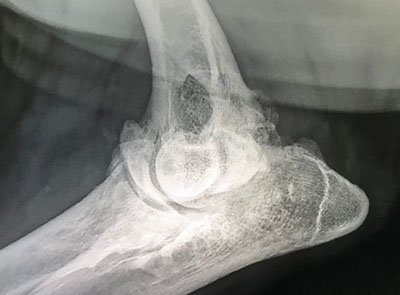 Upcoming Trialed Treatments
Upcoming Trialed Treatments
More recently a variety of intra-articular treatments have been trialled and these have shown some promise in managing these conditions using a multi-modal approach. Hyaluronic acid and other joint lubricants have been used to help smooth joint articulation in OA but medium to long term effects appear to be limited. Lack of efficacious treatments for ED has resulted in trials of biological therapies such as Stem cell therapy and platelet rich plasma (PRP) (15-19). These therapies used under the new branch of medicine, termed regenerative medicine (RM), show great promise of better treating the disease and actually having a disease modifying effect rather than just treating the symptoms such as pain.
Treatments Used at Greenside: Stem Cell Therapy
At Greenside we have been using stem cell therapy along with PRP to treat ED for a number of years and have modified our protocols with experience to develop a minimally invasive highly effective treatment option. Using RM we are able to stop the degenerative process, reverse some of the signs of OA and restore joint health. Although RM cannot reverse the process (the dysplasia or abnormal development of the elbow joint) that results in the formation of OA we have shown it to be highly effective in managing the condition with outcomes and longevity of effects that out perform many surgical interventions and conservative management (20 and 21). We are able to resolve lameness, reduce pain and improve function for extended periods of time. Positive treatment responses commonly last for 18 months to two years before a top up injection is required.
Because RM cannot reverse the underlying ED, with time, the joint will start to degenerate again. At this point further treatment can be provided to regain control and arrest the degenerative process. Once stem cells have been harvested from the patient with a small surgical procedure done under general anaesthetic, we are able to culture the stem cells to provide the required numbers needed for effective treatment. We can also store these stem cells in liquid nitrogen in a process called cryopreservation.
This means we have a supply of stem cells usually for the lifetime of the patient. When a further treatment is required we can simply wake these cells up at the lab and culture more without having to harvest more adipose tissue (fat) from the patient.
Culturing the stem cells has many advantages such as knowing the exact concentration and viability of cells to provide a reliable “dose” specific to the condition being treated. The sterility, morphology and purity of the resultant cultured stem cells are checked prior to shipment from the lab to ensure patient safety and ensure the best possible cells are used.
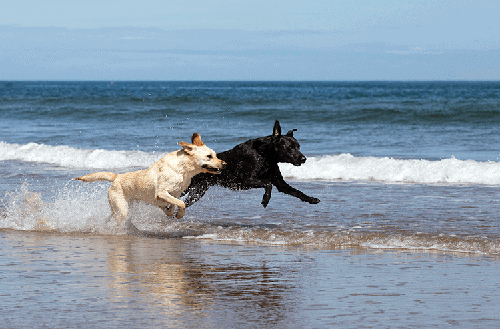 From our extensive experience of treating ED we have found that dogs that have undergone arthroscopic intervention prior to treatment with RM tend to do less well than those dogs not having the procedure. We believe this is due to the invasive nature of arthroscopy and for the potential to cause further instability and more severe OA changes following FCP removal and curetting of the cartilage. For this reason we do not advocate the use of arthroscopy to manage ED. Patients that have had arthroscopy need to be treated more aggressively with RM requiring two treatments 12 weeks apart and the addition of hyaluronic acid into the treatment plan. We have improved our outcomes in these patients but repeat treatments are more commonly required on an annual basis.
From our extensive experience of treating ED we have found that dogs that have undergone arthroscopic intervention prior to treatment with RM tend to do less well than those dogs not having the procedure. We believe this is due to the invasive nature of arthroscopy and for the potential to cause further instability and more severe OA changes following FCP removal and curetting of the cartilage. For this reason we do not advocate the use of arthroscopy to manage ED. Patients that have had arthroscopy need to be treated more aggressively with RM requiring two treatments 12 weeks apart and the addition of hyaluronic acid into the treatment plan. We have improved our outcomes in these patients but repeat treatments are more commonly required on an annual basis.
Associated Conditions & Problems
In patients presenting with ED and OA we commonly find other problems associated with this disease process in the shoulders. Patients with ED have altered gait and loading patterns due to pain in the medial compartment of the elbow. This results in changes to the directional forces within the shoulder support structures and tendons involved in shoulder and elbow movement. For this reason we always evaluate a patients shoulder soft tissue structures with musculoskeletal ultrasound when they present with ED
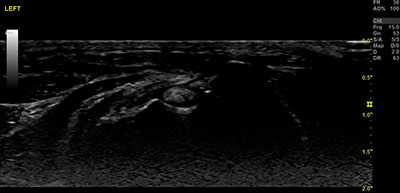 In our experience 95% of dogs with ED have concurrent shoulder tendon problems which can result in another significant source of pain and loss of function. In addition to the mechanical effects of altered gait, elbows that have advanced OA changes commonly have a significant reduction in range of motion (ROM). This is due to new arthritic bone formation throughout the joint and thickening and fibrosis of the joint capsule, physically obstructing joint flexion and extension. This has secondary consequences which result in shoulder tendon degeneration. Disease or degeneration in other parts of the body or other limbs can also play a role due to compensatory adaptations to lameness and pain.
In our experience 95% of dogs with ED have concurrent shoulder tendon problems which can result in another significant source of pain and loss of function. In addition to the mechanical effects of altered gait, elbows that have advanced OA changes commonly have a significant reduction in range of motion (ROM). This is due to new arthritic bone formation throughout the joint and thickening and fibrosis of the joint capsule, physically obstructing joint flexion and extension. This has secondary consequences which result in shoulder tendon degeneration. Disease or degeneration in other parts of the body or other limbs can also play a role due to compensatory adaptations to lameness and pain.
Fortunately RM is highly effective, if used with specific bespoke protocols, in treating OA and other degenerative conditions such as tendon degeneration. Not all stem cell treatments and PRP therapies are the same and many have not been validated in dogs which can result in sub optimal treatment outcomes.
The Greenside Specialists Approach
At Greenside we have investigated and trialled many different products and we believe we have found and validated the best possible products to ensure successful and consistent positive treatment outcomes.
 RM is a targeted treatment that requires a holistic approach to treat all causes of pain and degeneration within the body simultaneously to get the best treatment responses. We therefore perform a thorough physical examination and perform further diagnostic tests (e.g. X-rays and MSK Ultrasound) to diagnose concurrent orthopaedic musculoskeletal conditions. All MSK diseases are amenable for treatment using RM if correctly diagnosed and specifically targeted. This includes many spinal conditions. Bloods are also taken to look as the patients general health profile and check thyroid levels as other non-orthopaedic disease processes can effect treatment outcomes if not identified.
RM is a targeted treatment that requires a holistic approach to treat all causes of pain and degeneration within the body simultaneously to get the best treatment responses. We therefore perform a thorough physical examination and perform further diagnostic tests (e.g. X-rays and MSK Ultrasound) to diagnose concurrent orthopaedic musculoskeletal conditions. All MSK diseases are amenable for treatment using RM if correctly diagnosed and specifically targeted. This includes many spinal conditions. Bloods are also taken to look as the patients general health profile and check thyroid levels as other non-orthopaedic disease processes can effect treatment outcomes if not identified.
Greenside regenerative therapies and rehabilitation was the first specialist referral centre in the UK to provide treatments using stem cell therapy and rehabilitation and we use objective data to ensure our patients are improving and to modify treatments using an evidence based approach rather than only subjective assessment. After treatment we monitor our patients and provide support including home exercise plans and rehabilitative therapies. We offer regular reassessments and remote support as required. There is no cure for ED but Greenside has developed a more efficacious treatment option providing reduced pain, increased function and a better quality of life for your pet.
Case Studies
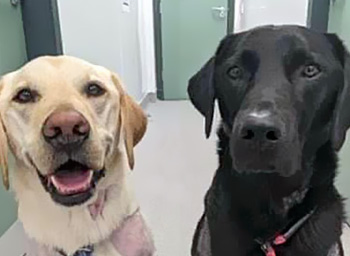 Magic & Merlin - Elbow dysplasia case study of two brothers
Magic & Merlin - Elbow dysplasia case study of two brothers
Elbow dysplasia (ED) is one of the most common causes of thoracic limb lameness in Labradors and other large and giant breed dogs and it is seen very frequently in our clinic.
ED is a term used to describe the presence of one or more developmental conditions involving the elbow joint. These conditions develop in juvenile animals and pain and lameness are often present at four to six months of age. Many dogs do not present until much later when osteoarthritis (OA) is advanced and lameness is a constant feature.
References:
- Michelsen J. Canine elbow dysplasia: aetiopathogenesis and current treatment recommendations. The Veterinary Journal. 2013 Apr 1;196(1):12-9.
- Samoy Y, Van Ryssen B, Gielen I, Walschot N, Van Bree H. Elbow incongruity in the dog. Vet Comp Orthop Traumatol. 2006;19:1-8.
- Cook CR, Cook JL. Diagnostic imaging of canine elbow dysplasia: a review. Veterinary Surgery. 2009 Feb;38(2):144-53.
- Kirberger RM, Fourie SL. Elbow dysplasia in the dog: pathophysiology, diagnosis and control. Journal of the South African Veterinary Association. 1998 Jul 12;69(2):43-54.
- Fitzpatrick N, Bertran J, Solano MA. Sliding humeral osteotomy: medium‐term objective outcome measures and reduction of complications with a modified technique. Veterinary Surgery. 2015 Feb;44(2):137-49.
- Quinn R, Preston C. Arthroscopic assessment of osteochondrosis of the medial humeral condyle treated with debridement and sliding humeral osteotomy. Veterinary Surgery. 2014 Oct;43(7):814-8.
- Gutbrod A, Guerrero TG. Effect of external rotational humeral osteotomy on the contact mechanics of the canine elbow joint. Veterinary Surgery. 2012 Oct;41(7):845-52.
- Fitzpatrick N, Yeadon R. Working algorithm for treatment decision making for developmental disease of the medial compartment of the elbow in dogs. Veterinary Surgery. 2009 Feb 1;38(2):285.
- Fitzpatrick N, Caron A, Solano MA. Bi‐oblique dynamic proximal ulnar osteotomy in dogs: reconstructed computed tomographic assessment of radioulnar congruence over 12 weeks. Veterinary Surgery. 2013 Aug;42(6):727-38.
- McConkey MJ, Valenzano DM, Wei A, Li T, Thompson MS, Mohammed HO, Van der Meulen MC, Krotscheck U. Effect of the proximal abducting ulnar osteotomy on intra‐articular pressure distribution and contact mechanics of congruent and incongruent canine elbows ex vivo. Veterinary Surgery. 2016 Apr;45(3):347-55.
- Samoy YC, de Bakker E, Van Vynckt D, Coppieters E, van Bree H, Van Ryssen B. Arthroscopic treatment of fragmented coronoid process with severe elbow incongruity. Veterinary and Comparative Orthopaedics and Traumatology. 2013;26(01):27-33.
- Burton NJ, Owen MR, Kirk LS, Toscano MJ, Colborne GR. Conservative versus arthroscopic management for medial coronoid process disease in dogs: a prospective gait evaluation. Veterinary Surgery. 2011 Dec;40(8):972-80.
- Dempsey LM, Maddox TW, Comerford EJ, Pettitt RA, Tomlinson AW. A Comparison of owner-assessed long-term outcome of arthroscopic intervention versus conservative management of dogs with medial coronoid process disease. Vet Comp Orthop Traumatol. 2019;32(01):1-9.
- Dragoo JL, Meadows MC. The use of biologics for the elbow: a critical analysis review. Journal of shoulder and elbow surgery. 2019 Nov 1;28(11):2053-60.
- Kriston-Pál É, Czibula Á, Gyuris Z, Balka G, Seregi A, Sükösd F, Süth M, Kiss-Tóth E, Haracska L, Uher F, Monostori É. Characterization and therapeutic application of canine adipose mesenchymal stem cells to treat elbow osteoarthritis. Canadian Journal of Veterinary Research. 2017 Jan 1;81(1):73-8.
- Olsen A, Johnson V, Webb T, Santangelo KS, Dow S, Duerr FM. Evaluation of intravenously delivered allogeneic mesenchymal stem cells for treatment of elbow osteoarthritis in dogs: a pilot study. Veterinary and Comparative Orthopaedics and Traumatology. 2019 May;32(03):173-81.
- Kriston-Pál É, Haracska L, Cooper P, Kiss-Tóth E, Szukacsov V, Monostori É. A regenerative approach to canine osteoarthritis using allogeneic, adipose-derived mesenchymal stem cells. Safety results of a long-term follow-up. Frontiers in veterinary science. 2020 Aug 13;7:510.
- Kim SE, Pozzi A, Yeh JC, Lopez-Velazquez M, Au Yong JA, Townsend S, Dunlap AE, Christopher SA, Lewis DD, Johnson MD, Petrucci K. Intra-Articular Umbilical Cord Derived Mesenchymal Stem Cell Therapy for Chronic Elbow Osteoarthritis in Dogs: A Double-Blinded, Placebo-Controlled Clinical Trial. Frontiers in veterinary science. 2019 Dec 20;6:474.
- Huňáková K, Hluchý M, Špaková T, Matejová J, Mudroňová D, Kuricová M, Rosocha J, Ledecký V. Study of bilateral elbow joint osteoarthritis treatment using conditioned medium from allogeneic adipose tissue-derived MSCs in Labrador retrievers. Research in Veterinary Science. 2020 Oct 1;132:513-20.
- Armitage A, Reid J. Measuring the impact of regenerative medicine (RM) on chronic degenerative conditions in dogs, using a validated owner-reported outcome measure (VetMetrica) which provides scores in 4 domains of health-related quality of life (HRQL). InBSAVA Congress Proceedings 2019 2019 Apr 1 (pp. 515-516). BSAVA Library.
- Armitage A, Miller J, Frost L, Standen C. Clinical efficacy of intra-articular injections of autologous mesenchymal stem cells in moderate to severe osteoarthritis (OA): a case series of 19 dogs evaluated using both LOAD and CBPI owner questionnaires. InBSAVA Congress Proceedings 2018 2018 Apr 1 (pp. 474-474). BSAVA Library.


